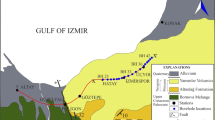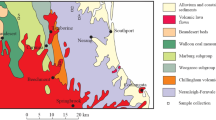Summary
A comprehensive range of classification, or index, and engineering design tests have been carried out on the seven stages of weathering of rock material recognised in the Hingston Down granite from east Cornwall, England. Interrelationships have been determined for all test results. It is concluded that the quick absorption, Schmidt hammer and point load strength tests are reliable and simple field tests for the determination of a quantitative weathering index. This quantitative weathering index can be related to visual determination of weathering stages of rock material, combinations of which can be used to categorize distinct weathering grades in the rock mass.
Résumé
Une suite complète de classification, ou index, et des essais techniques ont été effectués sur les sept phases d’altération du matériau rocheux reconnues dans le granite de Hingston Down à l’est de la Cornouailles (Angleterre). Les interrelations ont été déterminées pour tous les résultats des essais. On conclut que trois essais — absorption rapide, scléromètre Schmidt, et essai de résistance à une charge ponctuelle — sont des essais de terrain simples et fidèles pour la détermination d’un index quantitatif d’altération. Celui-ci peut être mis en relation avec la détermination visuelle des phases d’altération du matériau rocheux, dont les combinaisons peuvent être utilisées pour caractériser des degrès distincts d’altération dans la masse rocheuse.
Similar content being viewed by others
References
AKROYD T.N.W. (1957): Laboratory Testing in Soil Engineering Geotechnical Monograph No. 1,233pp.
ANON. (1972): The preparation of maps and plans in terms of engineering geology. Q. Jl Engng Geol., 5, 295–382.
BIENIAWSKI Z.T. (1975): The point load test in geotechnical practice. Engng Geol., 9, 1–11.
BROCH E. — FRANKLIN J.A. (1972): The point load strength test. Int. J. Rock Mech. Min. Sci. 9, 669–697.
BRITISH STANDARDS INSTITUTION (1967): British Standards BS1377: 1967, Methods for Sampling and Testing of Mineral Aggregates. Sands and Filers. London, British Standards Institution.
COATES D.F. (1970): Rock Mechanics Principles. Mines Branch Monograph, Ottawa.
COTTISS G.I. — DOWELL R.W. — FRANKLIN J.A. (1971): A rock classification system applied in civil engineering. Civil Engng and Public Works Review. Part 1, 611–614.
D’ANDREA D.V. — FISCHER R.L. — FOGELSON D.E. (1965): Prediction of compressive strength of rock from other properties. U.S. Bur. Mines Rep. Invest. 6702.
DEARMAN W.R. (1976): Weathering classification in the characterisation of rock: a revision. Bull. Int. Assoc. Engnǵ Geol. No. 13, 123–127.
DEARMAN W.R. — BAYNES F.J. — IRFAN T.Y. (1967): Practical aspects of periglacial effects on weathered granite. Proc. Ussher Soc. 3, 373–381.
DEARMAN W.R. — FOOKES P.G. (1972): The influences of weathering on the layout of quarries in South-West England. Proc. Ussher Soc. 2, 372–387.
DEERE D.U. (1963): Technical description of rock cores for engineering purposes. Rock Mech. and Engng Geol., 1, 16–22.
DEERE D.U. — MERRITT A.H. — COON R.F. (1969): Engineering classification of in situ rock. Report AFWL-67-144. Air Force Systems Command, Kirtland Air Force Base. New Mexico.
DEERE D.U. — MILLER R.P. (1966): Engineering classification and index properties for intact rock. Report AFWL-TR-65-116. Air Force Weapons Laboratory (WLDC). Kirtland Air Force Base. New Mexico 87117.
FRANKLIN J.A. (1960): Classification of rock according to its mechanical properties. Ph.D. Thesis. University of London.
Franklin J.A. (1972): Suggested methods for determing the slaking, porosity and related rock index properties. Final draft produced for International Society of Rock Mechanics, Commission on standardisation of laboratory and field tests, Lisbon.
HAMROL A. (1961): A quantitative classification of the weathering and weatherability of rocks. Proc. 5th Int. Conf. Soil Mech. and Found. Engng., Paris, 2, 771–774.
HAWKES I. — MELLOR M. (1970): Uniaxial testing in rock mechanics laboratories. Engng Geol. 4, 177–285.
ILIEV I.G. (1967): An attempt to estimate the degree of weathering of intrusive rocks from their physico-mechanical properties. Proc. 1st Cong. Int. Soc. Rock Mech., Lisbon, 109–114.
IRFAN T.Y. (1977): Engineering properties of weathered granite. Unpublished Ph. D. Thesis, University of Newcastle upon Tyne.
IRFAN T.Y. — DEARMAN W.R. (1978): Engineering petrography of a weathered granite (in press).
I.S.R.M. (1973): Suggested method for determining the point-load strength index. ISRM Committee on Laboraotry Tests, Document 1, 8–12.
ONODERA T.F. — YASHINAKA R. — ODA M. (1974): Weathering and its relation to mechanical properties of granite. Proc. 3rd Int. Cong. Soc. Rock Mech., Denver, Paper 2-A, 71–78.
REID C. — BARROW G. — SHERLOCK R.L. — MAC ALISTER D.A. — DEWEY H. (1911): Geology of the country around Tavistock and Launceston. Mem. Geol. Surv. G.B.
SZLAVIN J. (1974): Relationships between some physical properties of rock determined by laboratory tests. Int. J. Rock Mech. Min. Sci., 11, 57–66.
TERZAGHI K. — PECK R.B. (1967): Soil Mechanics in Engineering Practice, New York, Wiley 2nd ed.
Author information
Authors and Affiliations
Rights and permissions
About this article
Cite this article
Irfan, T.Y., Dearman, W.R. Engineering classification and index properties of a weathered granite. Bulletin of the International Association of Engineering Geology 17, 79–90 (1978). https://doi.org/10.1007/BF02634696
Published:
Issue Date:
DOI: https://doi.org/10.1007/BF02634696




